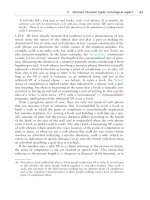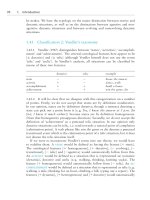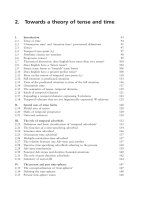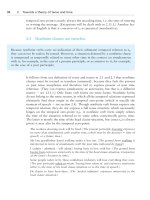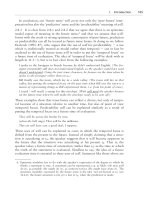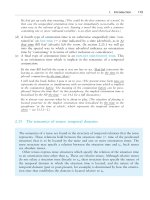The grammar of the english verb phrase part 113 potx
Bạn đang xem bản rút gọn của tài liệu. Xem và tải ngay bản đầy đủ của tài liệu tại đây (71.04 KB, 7 trang )
Glossary 777
but it was not yet a fact at the time of the head clause situation and the speaker
leaves it vague whether Bill eventually arrived or not.)
Factual full situation: In clauses in one of the perfect tenses with a continuative
reading, this term refers to that part of the full situation that has actualized in
a period leading up to the relevant orientation time (which is the temporal
zero-point in the case of the present perfect). Thus, in Meg has been talking to
the elephant for an hour now, the temporal adverbial specifies not only the
length of the pre-present zone but also the duration of the situation time coin-
ciding with that pre-present zone. The full situation may or may not include
t
0
and extend into the post-present. If it does, it consists not only of a part that
is factual at t
0
but also of a ‘potential’ present and post-present part. The part
that is factual at t
0
is called the ‘factual full situation’. The entire situation,
including both the t
0
-factual part and the potential part, is called the ‘potential
full situation’.
Finite clause: clause whose verb form is a finite verb form.
Finite verb form: verb form that is marked for at least one of the grammatical
categories tense, mood, person and number. For example, the finite verb form
works is marked for tense (present), mood (indicative), person (third) and
number (singular). (By contrast, a verb form that is an infinitive, gerund or
participle is a nonfinite verb form.)
Focalizing
when
-clause: when-clause which does not specify the time of the
head clause situation (or a time to which the time of the head clause situation
is related) but expresses the speaker’s temporal focus on a time of evaluation
or observation. In one subtype, the when-clause suggests the idea of a travelling
observing consciousness (e. g. When you travel to Washington, Boston, Chicago
or New York, the same problems exist), in another, the focalizing when-clause
indicates the ‘epistemic time of evaluation’, i. e. the time when the conclusion
is reached that the statement made in the head clause is true (e. g. When you
look at the economics, this company needs a Japanese and a European partner
to make it work).
Foreground: in a narrative text, the linguistic material (sentences and clauses)
which ‘pushes forward’ the story through time. (This material is said to have
a ‘foregrounding’ function.) It is the foregrounding sentences and clauses of a
story that form the ‘backbone’ of the story.
Foregrounding: see foreground.
Free indirect speech: type of represented speech in which an utterance or
thought is represented in the form of an independent clause (which is not a
quotation) rather than in the form of a subclause depending on a reporting
778 Glossary
clause (as is the case in indirect reported speech sentences like [He said] that
he was ill and had to stay at home). For example: [He let me know that he
couldn’t come.] He was ill. He had to stay at home. In free indirect speech,
what is reported is more often a thought than an utterance: [He took her threat
seriously.] She would not hesitate to carry it out. The report retains some
typical characteristics of a direct speech clause. Thus, it can have the form
of a direct question (i. e. with inversion) (e. g. [The constable looked at me
uncomprehendingly.] Why ever did I insist on being arrested?), it can be fol-
lowed by a question tag (e. g. So, that was what they were going to do, was
it?), etc.
Free relative clause (or headless relative clause, nominal relative clause): rela-
tive clauses without an overt antecedent (ϭ head), i. e. whose antecedent is
incorporated into the relative pronoun itself. For example: what he wanted
(which means ‘that which he wanted’). Because there is no overt noun as ante-
cedent, the relative clause itself functions syntactically like a noun phrase.
Thus, in What he wanted was unreasonable, the free relative clause has the
nominal function of subject. (This is why we can speak of ‘nominal relative
clause’.)
Full situation: the complete situation (referred to in a clause) as it actualizes
in whatever possible world is being referred to. The full situation should be
distinguished from the predicated situation. The latter is that part of the full
situation (possibly all of it) about which a claim is made in the clause. As is
clear from Two minutes ago John was in the library (which does not exclude
that John is still there), it is the predicated situation rather than the full situa-
tion that is located in time by the use of a particular tense.
Full verb: see lexical verb.
Future: (a) As a noun, future can be short for ‘future tense’ or can be used as
a nontechnical term meaning ‘post-present zone’. (b) As an adjective, future is
usually linked up with post-present time reference. For example, future situa-
tion means ‘post-present situation’, which is short for ‘situation whose situa-
tion time is located in the post-present zone’. Similarly, when we speak of
future time reference, we normally mean ‘reference to a time lying in, or being
coextensive with, the post-present time-zone’. Occasionally future indicates a
relation of posteriority to an orientation time other than the temporal zero-
point. For example, we can say that in Ten years later Bill {was to / would}
be the richest man in town, the verb form was to be or would be expresses
‘future in the past’ or (more correctly) ‘future from the past’, i. e. future relative
to a past orientation time.)
Future continuous: progressive form of the future tense.
Future perfect: see future perfect tense.
Glossary 779
Future perfect tense (or future perfect): tense which is formed by combining
the future tense auxiliary will (or shall) with a perfect infinitive. The future
perfect is an absolute-relative tense, because it combines an ‘absolute relation’
with a relative one: will expresses T-posteriority to the zero-point, thus estab-
lishing a post-present domain, while have V-ed expresses T-anteriority to the
pseudo-zero-point in this post-present domain. This anteriority is similar either
to the relation of anteriority to t
0
expressed by the absolute past tense – com-
pare John left at five with [John will no longer be there at six because] he will
have left at five – or (more commonly) to the relation of anteriority to t
0
expressed by the present perfect – compare John has already left with John
will already have left (by then). Accordingly, the semantics of the future perfect
is: ‘The situation time is located anterior to the central orientation time of a
post-present domain.’ Since that central orientation time is treated as a pseudo-
zero-point, this comes down to saying that a future perfect form creates either
a pseudo-past subdomain or a pseudo-pre-present subdomain. In addition, the
future perfect can also be used as a ‘pseudo-absolute-relative’ tense, as in [He
will say that] he will have finished before 5 o’clock, where the origin of the T-
posteriority relation expressed by will is not the (real) zero-point but a post-
present pseudo-t
0
(viz. the situation time of will say).
Future tense: tense whose forms combine the present tense form of one of the
auxiliaries will or shall (the latter in the first person only) and a present infini-
tive (e. g. will come). The basic use of the future tense is to locate a situation
time in the post-present zone of the present time-sphere. However, in a post-
present domain, it can also be used as a pseudo-absolute tense (e. g. [I will say
that] I will be absent the next day.)
Future tense auxiliary: the auxiliary will or shall (the latter in the first person
only) when it helps to build a form of the future tense (as in It will be cold
tomorrow) or of an absolute-relative tense like the future perfect (as in He will
have left by then).
Futurish tense form: verbal expression which arguably combines future time
reference with present time reference, more specifically, which links the post-
present actualization of a situation to a particular kind of present state. Exam-
ples of futurish tense forms are the present progressive in I’m leaving in a
minute,‘be going to ϩ present infinitive’ in It’s going to rain, and ‘be to ϩ
present infinitive’ in The Queen is to leave for Canada tomorrow. Like future
tense forms, futurish tense forms establish a post-present temporal domain.
Futurish verb form: see futurish tense form.
Futurity: see posteriority.
Generic sentence: universal sentence that predicates a typical characteristic of
a kind (species), e. g. Horses do not eat meat. The term is also sometimes
780 Glossary
applied to habitual sentences that predicate a typical and permanent (nontem-
porary) characteristic of an individual (e. g. Bill’s cat chases dogs).
Gerund: nonfinite verb form used in a gerund clause (e. g. [I want to avoid
her] getting [upset]). See also present gerund and perfect gerund.
Gerund clause: nonfinite clause whose verb form is a gerund and which is
typically used as a nominal clause, e. g. being gay in By next week, you will
write an essay on being gay {in antiquity / today / in the world of tomorrow}.
As this example shows, the situation time of being gay can be interpreted as
anterior, simultaneous or posterior to the situation time of the situation re-
ferred to in the head clause.
Grammatical aspect: the use of a special grammatical form (more specifically:
an inflectional suffix, an auxiliary or a combination of the two, as in the Eng-
lish progressive form) to express one of various meanings which have to do
with how the speaker views the internal temporal structure of a situation.
Grammatical auxiliary: auxiliary with a purely grammatical function, e. g. the
perfect tense auxiliary have.
Gricean Maxims: four principles of conversation, described by Grice (1975),
which are conventionally observed by cooperative speakers and hearers, and
which can trigger implicatures. See also Maxim of Quantity and Maxim of Re-
lation.
Habit: situation that is characteristic of the referent of the subject noun phrase
for an extended period of time (e. g. John smokes; Bill mostly walks to work).
Because it is a characteristic, a habit is by definition a state. It does not neces-
sarily involve repetition (e. g. I used to be afraid of the dark), but a habit is
mostly a habitual-repetitive situation.
Habitual: being or expressing a habit. John smokes is a ‘habitual sentence’. It
refers to a ‘habitual situation’. It has a ‘habitual meaning (interpretation)’, but
is not an instance of habitual aspect because it does not contain a special verb
form grammatically marking the situation as habitual. (The form smokes can
also be used with a nonhabitual interpretation, e. g. in the historic present.)
Habitual aspect: kind of grammatical aspect characterized by the fact that the
speaker uses a special verb form to represent a situation as a habit (i. e. as a
situation which is characteristic of the referent of the subject NP over an ex-
tended period of time). (e. g. She used to come and talk to him when she had
finished working).
Habitual-repetitive sentence: sentence referring to a habitual-repetitive situa-
tion.
Glossary 781
Habitual-repetitive situation: habit involving repetition, i. e. habitual situation
consisting of a number of similar or identical subsituations (e. g. She comes to
see me every night). A habitual-repetitive situation is an example of a hyper-
situation.
Habitual sentence: sentence interpreted as referring to a habitual situation.
Habitual situation: situation which is interpreted as being a habit, i. e. as being
characteristic of the referent of the subject NP over a certain period, e. g. the
situations referred to in John smokes, We’re eating outside while this spell of
good weather lasts, His dog is black. See also habitual-repetitive situation,
permanent habit, temporary habit.
Head (of a phrase): see phrase.
Head clause: clause which forms part of a complex sentence and on which
another clause (i. e. a ‘subclause’, ‘subordinate clause’, ‘dependent clause’, ‘em-
bedded clause’) is syntactically dependent. In John left after he had promised
he would finish the report, the matrix clause is John left. This clause is the
head clause on which the subclause with had promised depends. The latter
clause is itself the head clause of the subclause with would finish. As this
example shows, a head clause (or ‘superordinate clause’) may or may not be
the matrix of a complex sentence.
Headless relative clause (or free relative clause or nominal relative clause):
relative clause whose relative pronoun ‘contains’ a covert antecedent. For ex-
ample: what he wanted (which means ‘that which he wanted’). For more infor-
mation, see free relative clause.
Heterogeneous (or nonhomogeneous): (a) Ontological feature of a telic kind of
situation: ‘not homogeneous’. For example, the verb phrase run three miles
denotes a telic situation-template; it refers to a kind of situation which is not
interpreted as homogeneous (ϭ the same all the way through); this means that
the verb phrase is only applicable to the kind of situation as a whole: there is
no part of the situation type referred to by run three miles that can also be
referred to by this (nonprogressive) verb phrase; (b) On the level of the clause,
‘heterogeneous’ is a characteristic of the actualization of a concrete situation;
John is going to run three miles is a ‘heterogeneous clause’ because it can only
be used to refer to the post-present situation as a whole: there is no part of the
future (actualization of the) situation that can be satisfactorily referred to by
the same clause. As regards clauses and the actualizations they refer to, there
is a perfect correlation between the features [ϩ heterogeneous] and [ϩ
bounded]. Sheila drank a glass of beer refers to an actualization which is
bounded, and therefore heterogeneous, so that we can speak either of a
‘bounded sentence’ or of a ‘heterogeneous sentence’; (c) ‘Heterogeneous’ (or
782 Glossary
‘nonhomogeneous’) can also be applied to the (actualization of) a situation: a
bounded (or heterogeneous) clause refers to a bounded (or heterogeneous) situ-
ation; (d) The term ‘heterogeneous’ is also applied to an Adv-time and to the
adverbial indicating it: a heterogeneous Adv-time adverbial can only refer to
the Adv-time as a whole, not to any smaller portion of it (e. g. from 1983 to
1986). The Adv-time in question is then also said to be heterogeneous.
Historic present (or historical present): use of the present tense to locate the
situation time of a bygone situation in the present in order to represent this
situation vividly, as if it were actualizing here and now (e. g. Last night I’m
having a drink at the local pub. Suddenly this guy walks in and …).
Homogeneous: the opposite of ‘heterogeneous’. (a) On the level of the verb
phrase, ‘homogeneous’ is an ontological feature of a durative situation-tem-
plate: it means that a kind of situation is conceptualized as ‘the same all the
way through’, i. e. as consisting of parts which are all of the same kind as the
situation-template as a whole (e. g. drink beer). On this level, ‘homogeneous’
can be applied both to the kind of situation (which is then always atelic) and
to the verb phrase denoting it. (b) On the level of clauses, ‘homogeneous’ is an
inherent feature of nonbounded (actualizations of) situations. The sentence She
drank beer can be called either a ‘homogeneous sentence’ or a ‘nonbounded
sentence’. The actualization of the situation referred to, and by extension the
situation itself, can also be called ‘nonbounded’ or ‘homogeneous’. A homogen-
eous clause can refer not only to (the actualization of) a situation as a whole
but also to any representative part of it. Thus, if John was walking truly de-
scribes what John was doing between 2 o’clock and 4, it can also be used to
describe what John was doing between 2 and 3, and between 2.30 and 3, etc.
(c) In respect of Adv-times, homogeneity means that the Adv-time-adverbial
can indicate not only the Adv-time as a whole but also portions of it. For
example, today is a ‘homogeneous Adv-time-adverbial’ because any part of
today, whether bygone, present or future, can be referred to as today. This
explains why any of the absolute tenses is compatible with today: I had no
time for breakfast today, I haven’t seen him yet today, I’m 21 today, I’m feeling
queasy today, I will visit him today.
Hot news reading (or hot news interpretation): a particular usage type (func-
tional reading) of the indefinite perfect: the sentence in the present perfect is
used to ‘announce’ a bygone situation, i. e. to present the bygone actualization
of the situation in question as very recent and as having high current signifi-
cance. For example: [Have you heard?] Kim Clijsters has won the US Open!.
Hypersituation: repetitive situation, i. e. situation whose actualization involves
the actualization of a number of similar subsituations, e. g. [All the time I was
speaking] John was nodding assent; She stabbed him six times with her pen-
knife.
Glossary 783
Iconic sequencing: the unmarked interpretation of a sequence of two or more
bounded clauses using an absolute tense form: the situations referred to are
interpreted as actualizing in the temporal order in which they are referred to.
Thus, the unmarked interpretation of Bill hit John, who hit him is that John
hit Bill first, and then Bill hit John. (This unmarked interpretation can easily
be overruled by the context, as in Bill hit John, who hit him the day before,
or by pragmatic knowledge, as in The policeman arrested John, who robbed
the bank).
Illocutionary force: the illocutionary force of an utterance is the intention of
the speech act (e. g. promise, request, piece of advice, rebuke, etc.) performed
by the speaker by making the utterance. For example, Will you help me?, Shall
I drive you there? and You will do as I say! have the illocutionary force of a
request, an offer of service and an instruction, respectively.
Imperfective aspect: cover term for inchoative, progressive or egressive aspect.
Imperfective aspect is expressed by verb forms which do not refer to the actual-
ization of a situation as a whole, but only to its beginning, middle or end.
In English, progressive aspect is the only kind of imperfective aspect that is
grammaticalized.
Imperfective meaning: meaning conveyed by a verb form expressing imperfec-
tive aspect.
Imperfective verb form: verb form which expresses imperfective aspect, i. e.
which explicitly refers to only the beginning, middle or end of (the actualization
of) a situation, not to the complete situation. For example, in I was writing an
essay [when Henry came in] the progressive verb form was writing refers to
the middle of the situation only (hence the possible paraphrase ‘I was in the
middle of writing an essay [when Henry came in].’).
Implicate: to express an implicature, i. e. to suggest that something is the case
unless there is a contextual or pragmatic indication to the contrary. For exam-
ple, in clauses referring to a homogeneous situation the past tense implicates
that the actualization of the situation referred to is over at the temporal zero-
point. Thus, Tim was very angry suggests that Tim is no longer angry, but this
implicature can be blocked or cancelled by the context: It is blocked (prevented
from arising) by the presence of already in Tim was already very angry yester-
day, and it is cancelled (explicitly denied) in Tim was very angry – in fact he
still is.
Implicature: aspect of interpretation which does not follow from the semantic
meaning of a word, constituent or construction but which either follows from
contextual information or pragmatic knowledge of the world or results from
the application of conversational principles, such as the Gricean Maxims. It is
